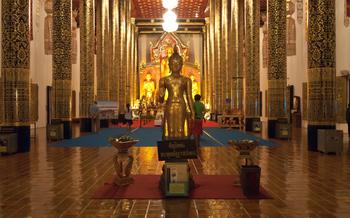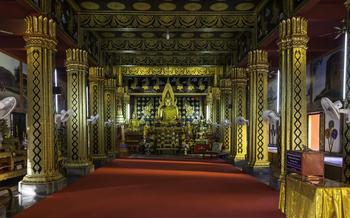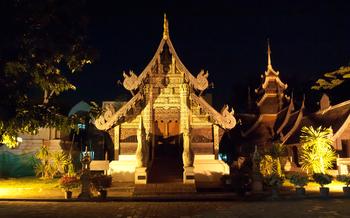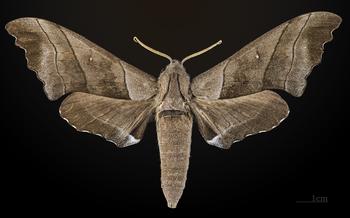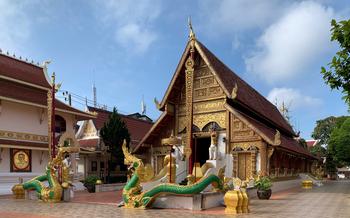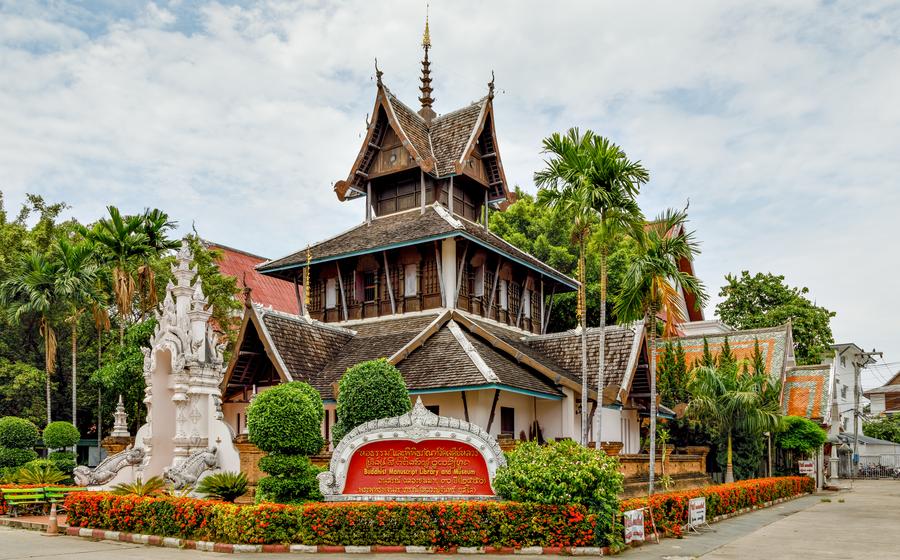
Wat Srisuphan (Silver Temple)
- History of the Temple
- Unique Silver Exterior
- Viharn (Main Hall)
- Ubosot (Ordination Hall)
- Chedi (Stupa)
- Silver Pavilion (Sala)
- Buddha Images
- Offerings and Rituals:
- Temple Grounds
- Admission and Timings
- Dress Code and Etiquette
- Photography and Videography
- Guided Tours
- Accessibility
- Insider Tip:
History of the Temple
The Wat Srisuphan, renowned for its gleaming silver exterior, holds a significant place in the cultural and historical tapestry of Chiang Mai. Its construction dates back to the 16th century, during the reign of the Lanna Kingdom. The temple's origins are intertwined with the patronage of wealthy merchants who sought to create a sacred space that would symbolize their devotion and prosperity. Over the centuries, the temple underwent various renovations and expansions, reflecting the evolving artistic styles and beliefs of the Lanna people.
In the 19th century, a major restoration effort was undertaken to preserve the temple's unique silver facade, which had suffered from the effects of time and weathering. Artisans skilled in traditional metalworking techniques were commissioned to meticulously restore the intricate silver artwork, breathing new life into the temple's resplendent exterior. Today, the Wat Srisuphan stands as a testament to the enduring legacy of the Lanna Kingdom, showcasing the artistry, devotion, and cultural heritage of the region.
Unique Silver Exterior
The Wat Srisuphan's most striking feature is its unique silver exterior, which sets it apart from other temples in Thailand. The temple's facade is adorned with intricate silver artwork and craftsmanship, showcasing the skill and artistry of Lanna artisans. The silver adornments include intricate designs, motifs, and figures that depict scenes from Buddhist mythology and folklore.
The use of silver in the temple's design holds significant symbolism. In Thai culture, silver is associated with purity, wealth, and prosperity. By covering the temple in silver, the builders aimed to create a sacred space that reflected the divine nature of Buddhism and the wealth of the Lanna Kingdom. The silver exterior also serves as a testament to the devotion and generosity of the local community, who donated their silver to support the temple's construction.
The process of creating the silver adornments was a complex and time-consuming one. Artisans used traditional techniques to mold and shape the silver into intricate designs. Each piece was carefully crafted by hand, ensuring that no two pieces were exactly alike. The resulting artwork is a testament to the skill and dedication of the Lanna craftsmen who created it.
Viharn (Main Hall)
The Viharn, or main hall, of the Wat Srisuphan is a testament to the architectural prowess of the Lanna Kingdom. Its elegant Lanna-style design features a tiered roof with intricate gable ends adorned with intricate silverwork. Inside, the hall is dominated by a majestic Buddha image enshrined on a silver pedestal. The image, known as Phra Jao Thong, is believed to date back to the 16th century and is revered by local devotees. The walls of the Viharn are adorned with vibrant murals depicting scenes from the life of Buddha and other Buddhist teachings, adding to the sacred atmosphere of the hall. Visitors can observe devotees performing rituals and making offerings to the Buddha image, gaining a glimpse into the spiritual practices of the local community.
Ubosot (Ordination Hall)
The Ubosot, also known as the ordination hall, holds a sacred and significant place within the Wat Srisuphan temple complex. It serves as a dedicated space for Buddhist ordinations, a crucial ritual where individuals formally enter the Buddhist monastic order. The Ubosot's architectural design echoes the Lanna-style prevalent in the region, characterized by its elegant and intricate wooden carvings and ornate gables.
Stepping inside the Ubosot, visitors are greeted by a serene and spiritual atmosphere. The hall is adorned with exquisite silver decorations, reflecting the temple's overall theme of silver artistry. Murals depicting significant events from the life of Lord Buddha and other Buddhist tales adorn the walls, adding to the sacred ambiance of the space.
The Ubosot is not only a venue for ordinations but also a place for various religious ceremonies and rituals. Monks gather here to chant scriptures, meditate, and perform other spiritual practices. Devotees come to the Ubosot to offer prayers, make offerings, and seek blessings from the resident monks.
The Ubosot plays a vital role in the spiritual life of the local community. It is a place where individuals can come to seek guidance, learn about Buddhist teachings, and participate in religious ceremonies. The Ubosot's significance extends beyond its physical structure; it represents a sacred space where the community gathers to strengthen their spiritual connection and foster a sense of unity and harmony.
Chedi (Stupa)
The Chedi, or stupa, is a prominent structure within the Wat Srisuphan compound. It is distinguished by its striking silver exterior, which reflects the sunlight and creates a mesmerizing spectacle. The Chedi's architectural style is a blend of Lanna and Burmese influences, showcasing intricately carved silver designs and ornamentation. The Chedi's shape symbolizes the Buddha's path to enlightenment, with its tiers representing the different stages of his spiritual journey. At the pinnacle of the Chedi, a golden stupa glistens, representing the ultimate attainment of nirvana.
The Chedi is not just a decorative element; it holds deep religious significance. It is believed to enshrine sacred relics or objects associated with the Buddha or other revered figures. Devotees often make offerings and circumambulate the Chedi as a form of merit-making and to seek blessings. The Chedi serves as a powerful reminder of the Buddha's teachings on impermanence and the ultimate goal of liberation from suffering.
Silver Pavilion (Sala)
Within the sacred grounds of Wat Srisuphan, the Silver Pavilion, also known as the Sala, stands as a testament to the temple's exquisite craftsmanship and intricate silverwork. This elegant structure serves as a place of contemplation, meditation, and religious ceremonies, inviting visitors to immerse themselves in the spiritual atmosphere of the temple.
The Silver Pavilion is adorned with an array of intricate silver artwork, showcasing the exceptional skills of the Lanna artisans. Floral motifs, mythical creatures, and auspicious symbols dance across its surface, creating a mesmerizing visual tapestry that captures the essence of Thai artistry. The pavilion's elegant design and serene ambiance make it an ideal place for visitors to seek solace, find inner peace, and connect with the divine.
Buddha Images
The Wat Srisuphan houses a diverse collection of Buddha images, each with its own unique style, material, and significance. These images are not merely decorative elements but hold deep religious and spiritual meaning for Buddhist devotees. Among the most notable Buddha images are:
- Phra Phuttha Sihing Buddha Image: This revered image is believed to date back to the 9th century and is considered one of the most important Buddha images in Thailand. It is crafted from a rare alloy of gold, silver, and copper, and its serene expression exudes an aura of peace and tranquility.
- Phra Phuttha Maha Mani Ratana Patimakorn Buddha Image: This large and impressive Buddha image is made of solid gold and is adorned with precious gemstones. It is believed to have been created in the 15th century and is a testament to the craftsmanship and devotion of the Lanna Kingdom.
- Phra Phuttha Chinnarat Buddha Image: This graceful and elegant Buddha image is made of bronze and is known for its intricate details and harmonious proportions. It is considered one of the most beautiful Buddha images in Thailand and is highly revered by devotees.
Offerings and Rituals:
Devotees who visit the Wat Srisuphan engage in various offerings and rituals to express their devotion and seek blessings. The most common offering is the lighting of candles and incense sticks, which symbolize the dispelling of darkness and the purification of the mind. Flowers, representing beauty and impermanence, are also offered at the temple's many Buddha images.
Another significant offering is the donation of money or material goods to the temple. These donations support the upkeep of the temple and its activities, and they also serve as a way for devotees to accumulate merit and good karma.
Devotees also participate in various rituals at the Wat Srisuphan, including meditation and prayer. Meditation is a common practice among Buddhists, as it allows them to cultivate inner peace and mindfulness. Prayer, on the other hand, is a way for devotees to communicate with the divine and express their gratitude or petitions.
During special festivals and events, the Wat Srisuphan hosts elaborate ceremonies that attract large numbers of devotees. These ceremonies often involve chanting, music, and dance, and they provide a unique opportunity for visitors to experience the vibrancy and devotion of Thai Buddhism.
Temple Grounds
The temple grounds of Wat Srisuphan exude an atmosphere of serenity and tranquility, providing a sanctuary for visitors to escape the bustling city. The layout of the grounds is meticulously designed, with lush gardens, tranquil ponds, and elegant courtyards that offer picturesque views from every corner.
Strolling through the temple complex, visitors are greeted by meticulously manicured lawns, vibrant flower beds, and towering trees that cast a dappled shade over the pathways. The sound of birdsong fills the air, creating a harmonious symphony that enhances the peaceful ambiance.
One of the highlights of the temple grounds is the serene pond located in the heart of the complex. The crystal-clear waters reflect the shimmering silver spires of the temple, creating a breathtaking mirror image that captivates the eye. Visitors can pause here and enjoy a moment of reflection, taking in the beauty of their surroundings.
In addition to the natural elements, the temple grounds also feature several unique architectural structures. Intricate gateways, adorned with intricate carvings and silver embellishments, mark the entrances to different sections of the complex, inviting visitors to explore further.
Throughout the grounds, visitors will find various seating areas where they can rest and contemplate the temple's serene atmosphere. These areas are often adorned with traditional Thai sculptures, lanterns, and wind chimes that add to the tranquil ambiance.
Admission and Timings
Visiting the Wat Srisuphan is a free and enriching experience. Its doors are open to visitors every day of the week, allowing you to immerse yourself in its sacred atmosphere whenever your heart desires. The temple's gates swing open from 8:00 AM to 5:00 PM, providing ample time to explore its intricate silver artistry and serene grounds. While there are no strict restrictions on visiting hours, it's recommended to plan your visit during the morning or late afternoon to avoid the midday heat and capture the temple's beauty in the golden light. Whether you're a devout Buddhist, a history buff, or simply someone seeking tranquility, the Wat Srisuphan welcomes you with open arms to experience its spiritual essence and architectural wonders.
Dress Code and Etiquette
When visiting the Wat Srisuphan, it is important to dress respectfully and follow local customs. Visitors should wear modest clothing that covers their shoulders and knees. Avoid wearing shorts, tank tops, or revealing clothing. It is also considered disrespectful to wear shoes inside the temple, so visitors should remove their shoes before entering.
Inside the temple, visitors should maintain a respectful and quiet demeanor. Avoid loud talking, laughing, or other disruptive behavior. It is also important to be mindful of the monks and other devotees who may be praying or meditating. Photography and videography are allowed in the temple, but visitors should be respectful of others and avoid taking photos or videos of people without their permission.
Photography and Videography
The Wat Srisuphan's resplendent silver exterior and intricate artwork make it a popular subject for photography and videography. Visitors are generally allowed to take photos and videos for personal use, but there are a few guidelines to keep in mind.
Photography and videography are permitted in most areas of the temple, but it is important to be respectful of worshippers and avoid capturing images that may be considered intrusive or disrespectful. Flash photography is not allowed inside the Viharn (main hall) or Ubosot (ordination hall) to preserve the integrity of the temple's interior.
For those seeking professional photography or videography opportunities, it is advisable to seek permission from the temple authorities in advance. Professional photographers may need to pay a permit fee and adhere to specific guidelines to ensure that their work does not disrupt the temple's daily activities.
To capture the temple's beauty effectively, consider arriving early in the morning or late in the afternoon when the light is softer and more forgiving. Experiment with different angles and perspectives to showcase the temple's unique features, such as the intricate silverwork on the Chedi (stupa).
Share your stunning photos and videos of the Wat Srisuphan on social media to inspire and inform others about this remarkable temple's beauty and cultural significance. Tag your posts with relevant hashtags to connect with fellow travelers and enthusiasts.
Guided Tours
Guided tours of the Wat Srisuphan are available for visitors who want to learn more about the temple's history, significance, and unique features. These tours are typically led by knowledgeable guides who can provide insights into the temple's architecture, symbolism, and religious practices. Guided tours are a great way to get a deeper understanding of the temple and its cultural significance.
To book a guided tour, visitors can contact the temple office or a local tour operator. Some tours may require advance reservations, especially during peak tourist season. It is advisable to inquire about the availability and schedule of guided tours before visiting the temple.
In addition to general guided tours, the Wat Srisuphan may also offer specialized tours or experiences, such as meditation sessions, cultural workshops, or photography tours. These tours provide visitors with a unique opportunity to immerse themselves in the temple's spiritual and cultural atmosphere.
For those who prefer a self-guided tour, there are information panels and brochures available at the temple that provide details about the history, architecture, and significance of various features. Visitors can also download audio guides or use mobile apps to learn more about the temple at their own pace.
Accessibility
The Wat Srisuphan strives to be accessible and welcoming to visitors of all abilities. The temple grounds are generally well-maintained and offer paved pathways that make it easy to navigate for those with mobility challenges. However, it's important to note that some areas of the temple may have uneven surfaces or steps, so it's advisable to use caution when exploring.
For visitors with disabilities or limited mobility, it's recommended to contact the temple in advance to inquire about any specific accessibility needs or assistance that may be required. The temple staff is generally helpful and accommodating, and they may be able to provide information about accessible routes, ramps, or wheelchair rentals, if available.
Additionally, visitors can request assistance from the temple staff or fellow devotees to help them navigate the temple grounds and participate in religious activities. It's important to be respectful and understanding when seeking assistance, as the temple is a sacred place for many people.
Insider Tip:
- Discover the hidden history of the Wat Srisuphan by visiting the nearby Sri Suphan Museum. This museum houses a collection of artifacts, photographs, and documents that shed light on the temple's construction, restoration efforts, and cultural significance.
- For a unique perspective of the temple, climb to the top of the Chedi. The climb is challenging but offers breathtaking panoramic views of the temple grounds and the surrounding landscape.
- After your temple visit, indulge in a delicious meal at the nearby Khao Soi Khun Yai restaurant, known for its authentic and flavorful Khao Soi, a traditional Northern Thai curry noodle dish.
- To fully immerse yourself in the temple's serene atmosphere, consider staying overnight at the Wat Srisuphan's guesthouse. This unique experience allows you to witness the temple's tranquility at dawn and dusk, away from the crowds of daytime visitors.
